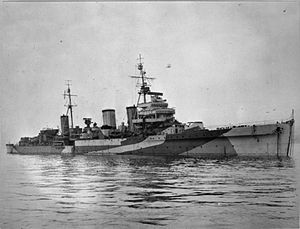 Enterprise in November 1943
| |
| History | |
|---|---|
| Name | Enterprise |
| Builder | John Brown & Company, (Clydebank, Scotland) |
| Yard number | 484 |
| Laid down | 28 June 1918 |
| Launched | 23 December 1919 |
| Commissioned | 7 April 1926 |
| Decommissioned | 13 January 1946 |
| Identification | Pennant number: 52 (Jan 26); I.52 (1936); D.52 (1940)[1] |
| Motto |
|
| Honours and awards |
|
| Fate | |
| Badge | On a field red, a lion rampant under a star silver. |
| General characteristics | |
| Class and type | Emerald-class light cruiser |
| Displacement | |
| Length | 570 ft (173.7 m) |
| Beam | 54 ft 6 in (16.6 m) |
| Draught | 16 ft 6 in (5.0 m) |
| Installed power |
|
| Propulsion | 4 × shafts; 4 × geared steam turbines |
| Speed | 33 knots (61 km/h; 38 mph) |
| Range | 8,000 nmi (15,000 km; 9,200 mi) at 15 knots (28 km/h; 17 mph) |
| Complement | 572 officers and ratings |
| Armament |
|
| Armour | |
| Aircraft carried | 1 × Seafox |
| Aviation facilities | 1 × catapult (later removed) |
HMS Enterprise was one of two Emerald-class light cruisers built for the Royal Navy. She was built by John Brown & Company, with the keel being laid down on 28 June 1918. She was launched on 23 December 1919, and commissioned on 7 April 1926. She was the 14th ship to serve with the Royal Navy to carry the name Enterprise, a name which is still used in the Royal Navy today.
Enterprise was completed with a prototype twin 6" turret in place of the original design two forward single mounts; and with the trials proving successful it was retained for the rest of her service career. This turret was later worked into the design of the Leander, Amphion and Arethusa classes. The turret installation occupied less space than the superimposed 'A' and 'B' guns of Emerald, therefore the bridge was placed further forward. The bridge was of a new design, being a single block topped by a director tower, rather than the traditional platforms built around the foremast and wheelhouse topped with a spotting top. This design of bridge would appear in the County-class cruisers.
- ^ Dodson, Aidan (2024). "The Development of the British Royal Navy's Pennant Numbers Between 1919 and 1940". Warship International. 61 (2): 134–66.